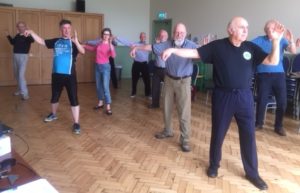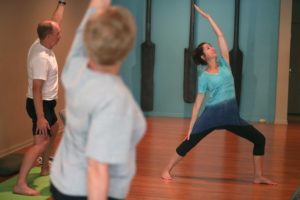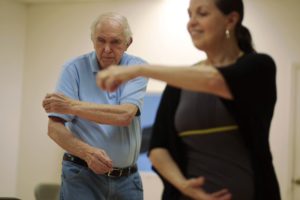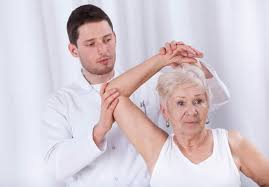Improve the Symptoms of Parkinson’s Disease with Mind-Body Practices
By John M. de Castro, Ph.D.
“The mind-body connection recognizes that emotional, mental, and behavioral factors can directly affect our health, and mind-body techniques can improve quality of life and may help reduce symptoms of disease.” – Emily Downward
Parkinson’s Disease (PD) is an incurable progressive degenerative disease of the central nervous system. The condition is caused by the death of nerve cells in the brain that produce the neurotransmitter dopamine. There are around seven million people worldwide and one million people in the U.S. living with PD and about 60,000 people are diagnosed with PD every year. PD is associated with aging as the vast majority of patients are diagnosed after age 50. In fact, it has been speculated that everyone would eventually develop PD if they lived long enough.
Its physical symptoms include resting tremor, slow movements, muscle rigidity, problems with posture and balance, loss of automatic movements, and slurring of speech. PD itself is not fatal but is often associated with related complications which can reduce life expectancy, such as falls, choking, and cardiovascular problems. Parkinson’s Disease (PD) also has psychological effects, especially cognitive decline, anxiety, and depression. All of these symptoms result in a marked reduction in the quality of life.
There are no cures for Parkinson’s Disease or even treatments to slow its progression. There are only treatments that can produce symptomatic relief. So, there is a need to discover new and different treatments. Mindfulness training has been found to improve the psychological symptoms and the quality of life with PD patients. In addition, Tai Chi practice has been shown to improve the symptoms of Parkinson’s Disease. Hence, mind-body practices may be excellent treatments for the symptoms of Parkinson’s Disease.
In today’s Research News article “The Impact of Mind-body Exercises on Motor Function, Depressive Symptoms, and Quality of Life in Parkinson’s Disease: A Systematic Review and Meta-analysis.” (See summary below or view the full text of the study at: https://www.ncbi.nlm.nih.gov/pmc/articles/PMC6981975/), Jin and colleagues review, summarize, and perform a meta-analysis of the effectiveness of mind-body practices for the relief of the symptoms of Parkinson’s Disease. They selected randomized controlled trials with Tai Chi, Qigong and Yoga practices for patients with Parkinson’s Disease over 40 years of age. They identified 22 studies with a total of 1199 participants, 18 of which employed Tai Chi and Qigong practices and 4 employed Yoga practice.
They report that the studies found that the mind-body practices produced significant improvements in overall Parkinson’s Disease motor function, walking ability, balance, depression, and quality of life. Hence, the published research studies demonstrate that mind-body practices significantly improve the physical and psychological symptoms of Parkinson’s Disease.
Tai Chi and Qigong practices have been demonstrated in prior research to improve balance, walking ability, depression, and quality of life in a variety of healthy and sick people. In addition yoga practice has been demonstrated to improve balance, walking ability, depression and quality of life in various populations. The present study extends these findings to patients with Parkinson’s Disease. These practices appear to be a safe and effective treatment to relieve the symptoms and suffering of patients with Parkinson’s Disease.
So, improve the symptoms of Parkinson’s Disease with mind-body practices.
“Mindfulness-based interventions have the ability to reprogram brain conditioning and alter the ways in which we respond to the world. Parkinson’s patients can benefit immensely from this method as a means of decreasing stress and anxiety while slowly increasing quality of life.” – Alana Kessler
CMCS – Center for Mindfulness and Contemplative Studies
This and other Contemplative Studies posts are also available on Google+ https://plus.google.com/106784388191201299496/posts and on Twitter @MindfulResearch
Study Summary
Jin, X., Wang, L., Liu, S., Zhu, L., Loprinzi, P. D., & Fan, X. (2019). The Impact of Mind-body Exercises on Motor Function, Depressive Symptoms, and Quality of Life in Parkinson’s Disease: A Systematic Review and Meta-analysis. International journal of environmental research and public health, 17(1), 31. https://doi.org/10.3390/ijerph17010031
Abstract
Purpose: To systematically evaluate the effects of mind-body exercises (Tai Chi, Yoga, and Health Qigong) on motor function (UPDRS, Timed-Up-and-Go, Balance), depressive symptoms, and quality of life (QoL) of Parkinson’s patients (PD). Methods: Through computer system search and manual retrieval, PubMed, Web of Science, The Cochrane Library, CNKI, Wanfang Database, and CQVIP were used. Articles were retrieved up to the published date of June 30, 2019. Following the Cochrane Collaboration System Evaluation Manual (version 5.1.0), two researchers independently evaluated the quality and bias risk of each article, including 22 evaluated articles. The Pedro quality score of 6 points or more was found for 86% (19/22) of these studies, of which 21 were randomized controlled trials with a total of 1199 subjects; and the trial intervention time ranged from 4 to 24 weeks. Interventions in the control group included no-intervention controls, placebo, waiting-lists, routine care, and non-sports controls. Meta-analysis was performed on the literature using RevMan 5.3 statistical software, and heterogeneity analysis was performed using Stata 14.0 software. Results: (1) Mind-body exercises significantly improved motor function in PD patients, including UPDRS (SMD = −0.61, p < 0.001), TUG (SMD = −1.47, p < 0.001) and balance function (SMD = 0.79, p < 0.001). (2) Mind-body exercises also had significant effects on depression (SMD = −1.61, p = 0.002) and QoL (SMD = 0.66, p < 0.001). (3) Among the indicators, UPDRS (I2 = 81%) and depression (I2 = 91%) had higher heterogeneity; according to the results of the separate combined effect sizes of TUG (I2 = 29%), Balance (I2 = 16%) and QoL (I2 = 35%), it shows that the heterogeneity is small; (4) After meta-regression analysis of the age limit and other possible confounding factors, further subgroup analysis showed that the reason for the heterogeneity of UPDRS motor function may be related to the sex of PD patients and severity of the disease; the outcome of depression was heterogeneous. The reason for this may be the use of specific drugs in the experiment and the duration of intervention in the trial. Conclusion: (1) Mind-body exercises were found to have significant improvements in motor function, depressive symptoms, and quality of life in patients with Parkinson’s disease, and can be used as an effective method for clinical exercise intervention in PD patients. (2) Future clinical intervention programs for PD patients need to fully consider specific factors such as gender, severity of disease, specific drug use, and intervention cycle to effectively control heterogeneity factors, so that the clinical exercise intervention program for PD patients is objective, scientific, and effective.
https://www.ncbi.nlm.nih.gov/pmc/articles/PMC6981975/









